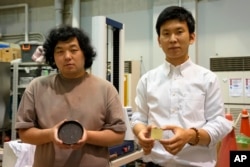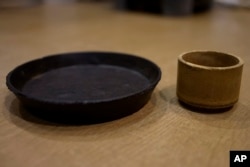University of Tokyo researchers in Japan have created a new technology that uses food waste in a surprising way.
Student Kota Machida and Professor Yuya Sakai say the operation can turn food waste into a strong but bendable material like cement. They say it is four times stronger than regular concrete, and is sustainable.
And, you can eat it, the researchers found.
Professor Sakai was looking for a way to replace cement-based concrete with sustainable materials. Cement production releases high levels of carbon dioxide waste into the air, says research group Chatham House.
Food waste is a big problem in Japan and the world. In 2019, Japan produced 5.7 million tons of food waste. The government is working on reducing this to 2.7 million by 2030.
The food waste that would typically end up in landfills, rotting, and releasing methane gas, can now be used to make the concrete. The material can be reused and buried in the ground if not needed without affecting the environment.
Sakai and Machida say they hope the new material can replace plastic and cement, and slow global warming linked to food waste, as well.
Creating food waste cement
At first Sakai used wood particles with heat and pressure to create the concrete, and then he moved onto food waste with plastics mixed in. Through a process of drying, crushing, and compressing the food waste, Sakai and his student Machida had successfully made cement from food waste without plastic. They adjusted the pressure and the temperature with simple equipment that can be bought from the internet.
"The most challenging part was that each type of food waste requires different temperatures and pressure levels," Sakai said.
The team have used different types of food waste to make the cement, including tea leaves, orange peels, coffee grounds, and leftover lunch materials.
Since the cement can be eaten, Sakai and Machida have changed the flavors with different spices. They have enjoyed the different colors, smell, and even the taste of the cement. Sakai said that in order to eat it a person needs to break it apart and boil it.
Machida, along with two friends have created a company called Fabula, Inc. They are working with other companies to use the material to make products for the home.
Sakai said that the process of creating the cement could be used to make temporary housing that can be eaten if a disaster happens. He said, "For example, if food cannot be delivered to evacuees, they could eat makeshift beds made out of food cement."
I’m Faith Pirlo.
Chisato Tanka reported this story for the Associated Press. Faith Pirlo adapted it for VOA Learning English.
__________________________________________________________________
Words in This Story
cement – n. a soft gray powder that is mixed with water and other substances to make concrete
construction – n. the process of building something
concrete – n. a hard, strong material that is used for building and made by mixing cement, sand, and broken rocks with water
sustainable – adj. involving methods that do not completely use up or destroy natural resources
emission – n. the act of releasing something
methane – n. a gas that has no color or smell that is used for cooking and heating
particles – n. a very small piece of something
challenging – adj. difficult in a way that is sometimes interesting or enjoyable
deliver –v. to provide
evacuees – n. people who are removed from a dangerous place
makeshift – adj. temporary or basic











